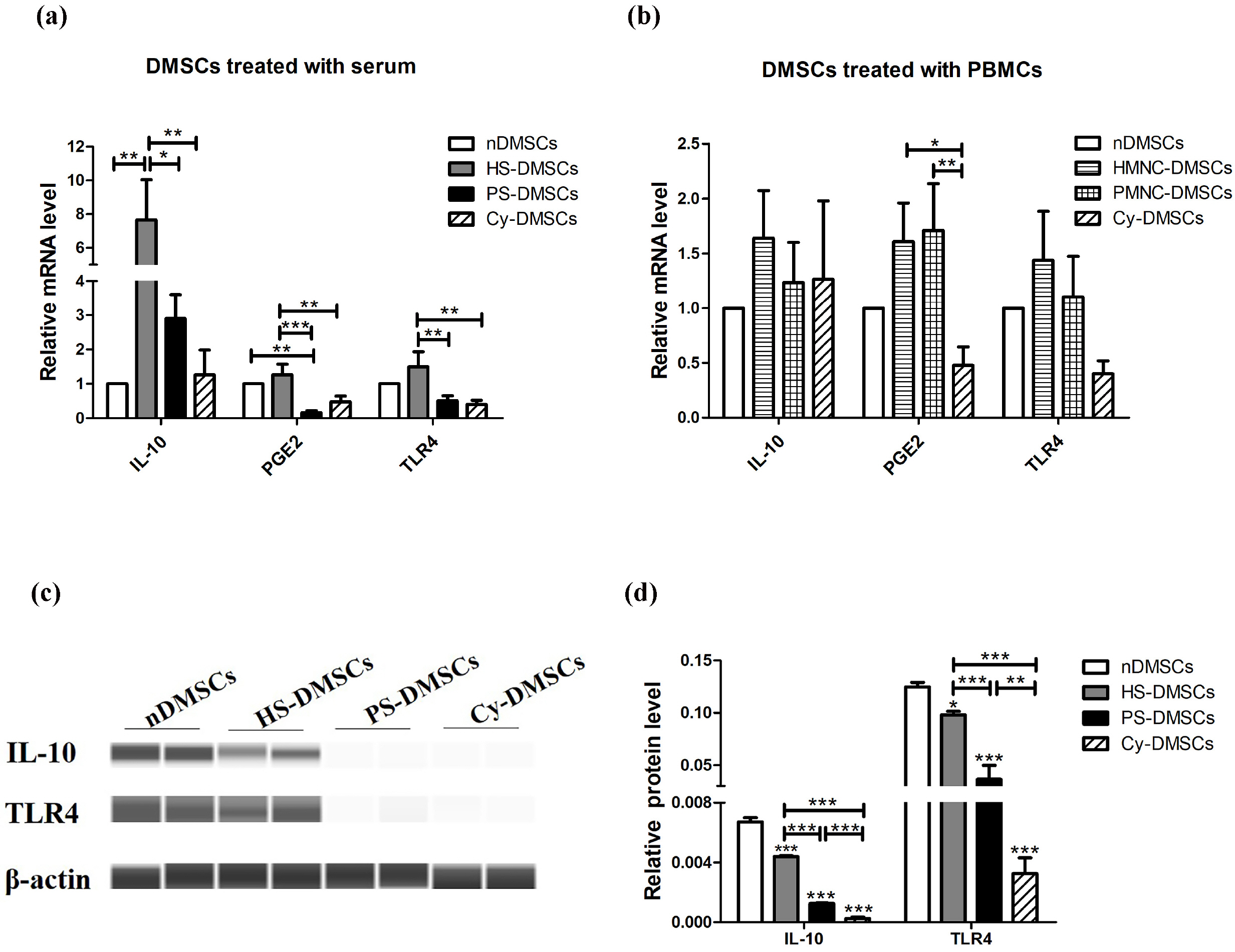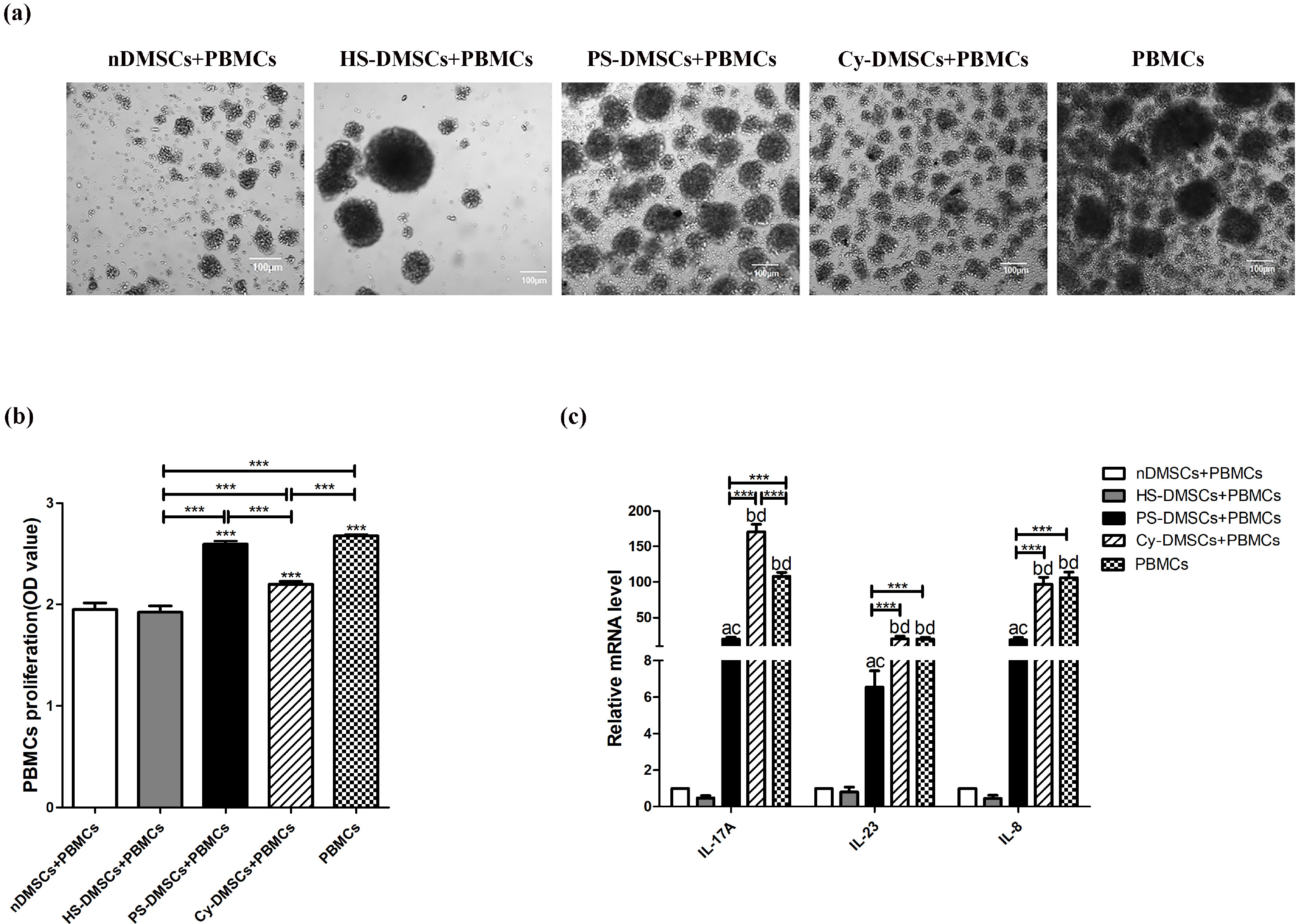Int J Stem Cells.
2022 May;15(2):155-163. 10.15283/ijsc20210.
Psoriatic Serum Induce an Abnormal Inflammatory Phenotype and a Decreased Immunosuppressive Function of Mesenchymal Stem Cells
- Affiliations
-
- 1Shanxi Key Laboratory of Stem Cells for Immunological Dermatosis, Institute of Dermatology, Taiyuan Central Hospital of Shanxi Medical University, Taiyuan, China
- KMID: 2529787
- DOI: http://doi.org/10.15283/ijsc20210
Abstract
- Background and Objectives
Mesenchymal stem cells (MSCs) have immunomodulatory function and participate in the pathogenesis of many immunoregulation-related diseases, including psoriasis. Previously, we found that MSCs from psoriatic lesions overexpress the proinflammatory microRNA, miR-155 and exhibit a decreased immunosuppressive capacity. But the origin of these aberrant characteristics is still not clear. To investigate whether inflammatory cytokines in serum and peripheral blood mononuclear cells (PBMCs) from psoriatic patients can regulate the expression patterns of immunoregulation-related cytokines and the immunoregulation function of MSCs.
Methods and Results
Normal dermal mesenchymal stem cells (nDMSCs) were treated with serum or PBMCs derived from patients with psoriasis or healthy donors. Expression of miR-155 and immunoregulation-related genes in each MSCs were measured using real-time PCR or western-blot. Meanwhile, the immunosuppressive capacity of DMSCs was evaluated by its inhibitory ability on proliferation of activated PBMCs. Compared to control serum, psoriatic serum significantly increased the expression levels of miR-155 (27.19±2.40 vs. 3.51±1.19, p<0.001), while decreased TAB2 expression (0.28±0.04 vs. 0.72±0.20, p<0.01) in DMSCs. Expression levels of immunoregulation-related genes such as PGE2, IL-10, and TLR4 were also markedly down-regulated following the psoriatic serum treatment. Those DMSCs treated with healthy serum could inhibit PBMC proliferation, while those psoriatic serum-treated DMSCs could not inhibit PBMC proliferation effectively.
Conclusions
Psoriatic serum up-regulate the expression of miR-155, down-regulate the expression of immunoregulation- related genes (PGE2, IL-10, and TLR4) in DMSCs, and along with the inhibition of the immunosuppressive function of MSCs.
Keyword
Figure
Reference
-
References
1. Liang Y, Sarkar MK, Tsoi LC, Gudjonsson JE. 2017; Psoriasis: a mixed autoimmune and autoinflammatory disease. Curr Opin Immunol. 49:1–8. DOI: 10.1016/j.coi.2017.07.007. PMID: 28738209. PMCID: PMC5705427.
Article2. Zhang P, Wu MX. 2018; A clinical review of phototherapy for psoriasis. Lasers Med Sci. 33:173–180. DOI: 10.1007/s10103-017-2360-1. PMID: 29067616. PMCID: PMC5756569.
Article3. Zhao L, Chen S, Yang P, Cao H, Li L. 2019; The role of mesenchymal stem cells in hematopoietic stem cell transplantation: prevention and treatment of graft-versus-host disease. Stem Cell Res Ther. 10:182. DOI: 10.1186/s13287-019-1287-9. PMID: 31227011. PMCID: PMC6588914. PMID: 3502f2e3c8e548ee8714319d24a999c4.
Article4. Andrukhov O, Behm C, Blufstein A, Rausch-Fan X. 2019; Immunomodulatory properties of dental tissue-derived mesenchymal stem cells: implication in disease and tissue regeneration. World J Stem Cells. 11:604–617. DOI: 10.4252/wjsc.v11.i9.604. PMID: 31616538. PMCID: PMC6789188.
Article5. Harrell CR, Jovicic N, Djonov V, Arsenijevic N, Volarevic V. 2019; Mesenchymal stem cell-derived exosomes and other extracellular vesicles as new remedies in the therapy of inflammatory diseases. Cells. 8:1605. DOI: 10.3390/cells8121605. PMID: 31835680. PMCID: PMC6952783.
Article6. Rashedi I, Gómez-Aristizábal A, Wang XH, Viswanathan S, Keating A. 2017; TLR3 or TLR4 activation enhances mesenchymal stromal cell-mediated Treg induction via Notch signaling. Stem Cells. 35:265–275. DOI: 10.1002/stem.2485. PMID: 27571579.
Article7. Hou R, Yan H, Niu X, Chang W, An P, Wang C, Yang Y, Yan X, Li J, Liu R, Li X, Zhang K. 2014; Gene expression profile of dermal mesenchymal stem cells from patients with psoriasis. J Eur Acad Dermatol Venereol. 28:1782–1791. DOI: 10.1111/jdv.12420. PMID: 24593802.
Article8. Liu R, Wang Y, Zhao X, Yang Y, Zhang K. 2014; Lymphocyte inhibition is compromised in mesenchymal stem cells from psoriatic skin. Eur J Dermatol. 24:560–567. DOI: 10.1684/ejd.2014.2394. PMID: 25445090.
Article9. Orciani M, Campanati A, Salvolini E, Lucarini G, Di Benedetto G, Offidani A, Di Primio R. 2011; The mesenchymal stem cell profile in psoriasis. Br J Dermatol. 165:585–592. DOI: 10.1111/j.1365-2133.2011.10438.x. PMID: 21623755.
Article10. Wojciechowska A, Braniewska A, Kozar-Kamińska K. 2017; MicroRNA in cardiovascular biology and disease. Adv Clin Exp Med. 26:865–874. DOI: 10.17219/acem/62915. PMID: 29068585.
Article11. Testa U, Pelosi E, Castelli G, Labbaye C. 2017; miR-146 and miR-155: two key modulators of immune response and tumor development. Noncoding RNA. 3:22. DOI: 10.3390/ncrna3030022. PMID: 29657293. PMCID: PMC5831915.
Article12. Rodriguez A, Vigorito E, Clare S, Warren MV, Couttet P, Soond DR, van Dongen S, Grocock RJ, Das PP, Miska EA, Vetrie D, Okkenhaug K, Enright AJ, Dougan G, Turner M, Bradley A. 2007; Requirement of bic/microRNA-155 for normal immune function. Science. 316:608–611. DOI: 10.1126/science.1139253. PMID: 17463290. PMCID: PMC2610435.
Article13. Xu C, Ren G, Cao G, Chen Q, Shou P, Zheng C, Du L, Han X, Jiang M, Yang Q, Lin L, Wang G, Yu P, Zhang X, Cao W, Brewer G, Wang Y, Shi Y. 2013; miR-155 regulates immune modulatory properties of mesenchymal stem cells by targeting TAK1-binding protein 2. J Biol Chem. 288:11074–11079. DOI: 10.1074/jbc.M112.414862. PMID: 23449975. PMCID: PMC3630877.
Article14. Hou RX, Liu RF, Zhao XC, Jia YR, An P, Hao ZP, Li JQ, Li XH, Yin GH, Zhang KM. 2016; Increased miR-155-5p expression in dermal mesenchymal stem cells of psoriatic patients: comparing the microRNA expression profile by microarray. Genet Mol Res. 15:gmr.15038631. DOI: 10.4238/gmr.15038631. PMID: 27706699.
Article15. Li X, Li J, Lu F, Cao Y, Xing J, Li J, Hou R, Yin G, Zhang K. 2020; Role of SPRED1 in keratinocyte proliferation in psoriasis. J Dermatol. 47:735–742. DOI: 10.1111/1346-8138.15369. PMID: 32396270.
Article16. Niu X, Li J, Zhao X, Wang Q, Wang G, Hou R, Li X, An P, Yin G, Zhang K. 2019; Dermal mesenchymal stem cells: a resource of migration-associated function in psoriasis? Stem Cell Res Ther. 10:54. DOI: 10.1186/s13287-019-1159-3. PMID: 30760317. PMCID: PMC6375130. PMID: ab2d99bcde9044cab53d07a1c5c40c43.
Article17. Michalak-Stoma A, Pietrzak A, Szepietowski JC, Zalewska-Janowska A, Paszkowski T, Chodorowska G. 2011; Cytokine network in psoriasis revisited. Eur Cytokine Netw. 22:160–168. DOI: 10.1684/ecn.2011.0294. PMID: 22236965.
Article18. Michalak-Stoma A, Bartosińska J, Kowal M, Juszkiewicz-Borowiec M, Gerkowicz A, Chodorowska G. 2013; Serum levels of selected Th17 and Th22 cytokines in psoriatic patients. Dis Markers. 35:625–631. DOI: 10.1155/2013/856056. PMID: 24288431. PMCID: PMC3832981.
Article19. Boehncke WH. 2015; Etiology and pathogenesis of psoriasis. Rheum Dis Clin North Am. 41:665–675. DOI: 10.1016/j.rdc.2015.07.013. PMID: 26476225.
Article20. Campanati A, Orciani M, Consales V, Lazzarini R, Ganzetti G, Di Benedetto G, Di Primio R, Offidani A. 2014; Characterization and profiling of immunomodulatory genes in resident mesenchymal stem cells reflect the Th1-Th17/Th2 imbalance of psoriasis. Arch Dermatol Res. 306:915–920. DOI: 10.1007/s00403-014-1493-3. PMID: 25160906.
Article21. Mareschi K, Castiglia S, Sanavio F, Rustichelli D, Muraro M, Defedele D, Bergallo M, Fagioli F. 2016; Immunoregulatory effects on T lymphocytes by human mesenchymal stromal cells isolated from bone marrow, amniotic fluid, and placenta. Exp Hematol. 44:138–150.e1. DOI: 10.1016/j.exphem.2015.10.009. PMID: 26577566.
Article22. Liu RF, Wang F, Wang Q, Zhao XC, Zhang KM. 2015; Research Note Mesenchymal stem cells from skin lesions of psoriasis patients promote proliferation and inhibit apoptosis of HaCaT cells. Genet Mol Res. 14:17758–17767. DOI: 10.4238/2015.December.21.49. PMID: 26782421.
Article23. Niu X, Chang W, Liu R, Hou R, Li J, Wang C, Li X, Zhang K. 2016; mRNA and protein expression of the angiogenesis-related genes EDIL3, AMOT and ECM1 in mesenchymal stem cells in psoriatic dermis. Clin Exp Dermatol. 41:533–540. DOI: 10.1111/ced.12783. PMID: 26644074.
Article24. Castro-Manrreza ME, Bonifaz L, Castro-Escamilla O, Monroy-García A, Cortés-Morales A, Hernández-Estévez E, Hernández-Cristino J, Mayani H, Montesinos JJ. 2019; Mesen-chymal stromal cells from the epidermis and dermis of psoriasis patients: morphology, immunophenotype, differentiation patterns, and regulation of T cell proliferation. Stem Cells Int. 2019:4541797. DOI: 10.1155/2019/4541797. PMID: 31885608. PMCID: PMC6914887. PMID: 65e75cdeb3774761bdf98d969592c11b.
Article25. Zhou Y, Yamamoto Y, Xiao Z, Ochiya T. 2019; The immuno-modulatory functions of mesenchymal stromal/stem cells mediated via paracrine activity. J Clin Med. 8:1025. DOI: 10.3390/jcm8071025. PMID: 31336889. PMCID: PMC6678920.
Article26. Sonkoly E, Pivarcsi A. 2009; Advances in microRNAs: implications for immunity and inflammatory diseases. J Cell Mol Med. 13:24–38. DOI: 10.1111/j.1582-4934.2008.00534.x. PMID: 19175698. PMCID: PMC3823034.
Article27. Kong Y, Zhang S, Wu R, Su X, Peng D, Zhao M, Su Y. 2019; New insights into different adipokines in linking the pathophysiology of obesity and psoriasis. Lipids Health Dis. 18:171. DOI: 10.1186/s12944-019-1115-3. PMID: 31521168. PMCID: PMC6745073. PMID: 8bafd9624fe8458fa2fdc24d1fa69d76.
Article28. Ceppi M, Pereira PM, Dunand-Sauthier I, Barras E, Reith W, Santos MA, Pierre P. 2009; MicroRNA-155 modulates the interleukin-1 signaling pathway in activated human monocyte-derived dendritic cells. Proc Natl Acad Sci U S A. 106:2735–2740. DOI: 10.1073/pnas.0811073106. PMID: 19193853. PMCID: PMC2650335.
Article29. Tan B, Mu R, Chang Y, Wang YB, Wu M, Tu HQ, Zhang YC, Guo SS, Qin XH, Li T, Li WH, Zhang XM, Li AL, Li HY. 2015; RNF4 negatively regulates NF-κB signaling by down-regulating TAB2. FEBS Lett. 589(19 Pt B):2850–2858. DOI: 10.1016/j.febslet.2015.07.051. PMID: 26299341.
Article30. Alhusaini A, Fadda LM, Ali HM, Hasan IH, Ali RA, Zakaria EA. 2019; Mitigation of acetamiprid - induced renotoxicity by natural antioxidants via the regulation of ICAM, NF-kB and TLR 4 pathways. Pharmacol Rep. 71:1088–1094. DOI: 10.1016/j.pharep.2019.06.008. PMID: 31629938.
Article31. Dorronsoro A, Ferrin I, Salcedo JM, Jakobsson E, Fernández-Rueda J, Lang V, Sepulveda P, Fechter K, Pennington D, Trigueros C. 2014; Human mesenchymal stromal cells modulate T-cell responses through TNF-α-mediated activation of NF-κB. Eur J Immunol. 44:480–488. DOI: 10.1002/eji.201343668. PMID: 24307058.
Article32. Gutierrez RMP, Hoyo-Vadillo C. 2017; Anti-inflammatory potential of Petiveria alliacea on activated RAW264.7 murine macrophages. Pharmacogn Mag. 13(Suppl 2):S174–S178. DOI: 10.4103/pm.pm_479_16. PMID: 28808377. PMCID: PMC5538151.33. Rodríguez M, Domingo E, Municio C, Alvarez Y, Hugo E, Fernández N, Sánchez Crespo M. 2014; Polarization of the innate immune response by prostaglandin E2: a puzzle of receptors and signals. Mol Pharmacol. 85:187–197. DOI: 10.1124/mol.113.089573. PMID: 24170779.
Article34. Selmani Z, Naji A, Zidi I, Favier B, Gaiffe E, Obert L, Borg C, Saas P, Tiberghien P, Rouas-Freiss N, Carosella ED, Deschaseaux F. 2008; Human leukocyte antigen-G5 secretion by human mesenchymal stem cells is required to suppress T lymphocyte and natural killer function and to induce CD4+CD25highFOXP3+ regulatory T cells. Stem Cells. 26:212–222. DOI: 10.1634/stemcells.2007-0554. PMID: 17932417.
Article
- Full Text Links
- Actions
-
Cited
- CITED
-
- Close
- Share
- Similar articles
-
- Immunosuppressive Effect of Exosomes from Mesenchymal Stromal Cells in Defined Medium on Experimental Colitis
- Role of Mesenchymal Stem Cells in Patients with Nontraumatic Osteonecrosis of the Femoral Head
- Induction of Indoleamine 2,3-dioxygenase by Pre-treatment with Poly(I:C) May Enhance the Efficacy of MSC Treatment in DSS-induced Colitis
- A Simple Method to Isolate and Expand Human Umbilical Cord Derived Mesenchymal Stem Cells: Using Explant Method and Umbilical Cord Blood Serum
- Current Trends and Prospect of Cell Therapy using Hematopoietic Stem Cells





